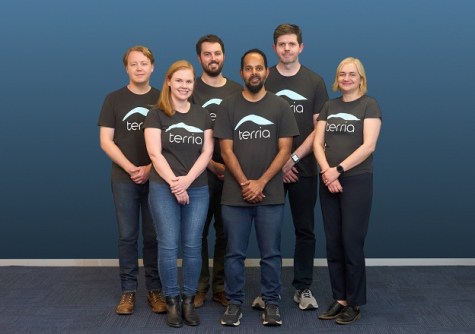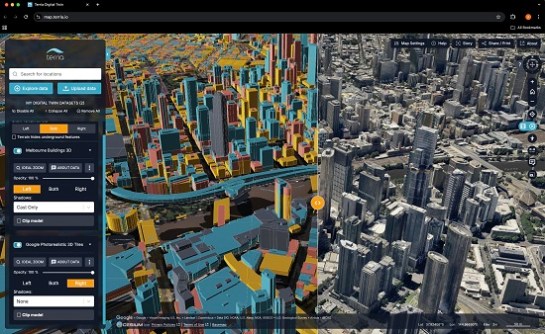
With many billions of dollars to be spent in the geospatial sector in the coming years, Terria has set its sights on grabbing a bigger share of the digital twin market.
By Jonathan Nally
Terria, the latest tech company to be spun out of the CSIRO, is aiming to grab its share of the expected $50 billion growth in the geospatial market over the next few years.
The company was established last year following a funding round led Main Sequence Ventures, a venture capital investor with $1 billion under management and which itself was spun out of the CSIRO in 2017.
According to Mike Nicholls, Partner at Main Sequence, “We first saw Terria a few years ago in the CSIRO Data61 lab and loved the products and how they were being adopted by users”.
“A typical city street has thousands of data sets and plans for buildings, streets, footpaths, electricity, water, sewage, telecommunications, parks, stations, transport, planning and the natural environment,” he said. “Terria can bring all that data together integrating 80 different formats and visualise this on one map.”
“We are excited to help spin this company out and look forward to them growing a huge customer base over the coming years.”
Fronting Terria are its co-founders, Ana Belgun (CEO) and Amber Standley (Chief Experience Officer). We spoke with both of them to find out more about the company, its history within CSIRO, its capabilities and ambitions.
How would you sum up Terria’s main purpose?
Ana Belgun: One of our main goals is not only to make the development of spatial digital twins much easier than it is today, but also to develop a geospatial software library which is open source. The purpose of that is to basically scale the impact that we have by developing software and products and allowing other teams around the world to use our technology and build their own platform applications.
How did the business begin?
AB: Basically, in 2014 we started with a problem. We were functioning as an engineering and design team within NICTA [which was merged into CSIRO in 2016 to become Data61]. The Australian Government at that time had the problem of producing a lot of spatially enabled datasets and they wanted to see a return on that investment by making sure people have access to those datasets in an easier way. The solutions that were on hand were very expensive and didn’t actually solve the core of the problem, which is, how do we make sure people better consume these data we make available for free?
So our team worked with the Government back then to create a prototype which became NationalMap, which was connected to data.gov.au to allow users to consume the data in an easier way. That was the beginning. And from then on, we evolved that use case into creating an entire technology which was made open source, which is TerriaJS.
Fast forward to 2018, we started in the same vein of trying to help or work with governments to experiment with technologies. We started working with state governments and developed the first spatial digital twins in Australia — there were no other examples in Australia that we could point to; the only one was in Singapore at that time. So it was very much a learning experience and a journey that we shared with everybody else, other governments, the Commonwealth etc, to make sure the investment government makes into such technologies and learning is scalable and other people can use it and derive value.

Why has Terria been spun out of CSIRO?
AB: Once research or technology reaches a maturity level, there are a number of ways that the CSIRO wants to scale that impact. They do it through licencing or they do it through creating new companies. So what they did in 2024, with support from Main Sequence Ventures, was to create a new company, Terria. The idea was to take the technology that we developed together with governments and government partners, and take it to a level of commercial success to ensure there is a long term sustainable plan to reinvest in the open source.
You’ve entered a very competitive sector.
AB: I think competition is good and healthy in order to create competitive products and services for the customers. The fact that we have a core technology which is open source speaks volumes, because we want to scale the impact that we have, and have other teams around the world building products and services and platforms.
However, in this competitive market, we believe that having that open source core, and a drive and knowledge around building platforms like spatial digital twins, with datasets that we help customers bring together into one platform, is a huge differentiator. We have had experience working with our partners in the Australian Government since 2014 on understanding the landscape of data in Australia and helping users have access to that data in an easier way.
Amber Standley: We are also focused on enabling people who aren’t developers to create digital twins easily and quickly. So that’s something that’s also a bit of a differentiator for Terria.
What sort of data is available through Terria?
AB: The data that is already available is produced mainly by government organisations. They invest a lot of their resources into creating datasets, and the degrees of complexity or the levels of updates brought to the data is controlled by the custodians of those datasets. Everything they publish, they control, in terms of how many times they update it, how high the quality is etc. And that’s good because you don’t want a middle kind of operation between the end user and the creator of the data. Whatever the government is deploying in terms of datasets, we help the users access them in one place through our Terria platform.
So right now we have a subset of that catalogue of open datasets in the Terria demonstration platform, which is available on the website. That catalogue will grow over time by adding more open datasets, but also having partnership with the commercial data providers, which we haven’t done before. So that’s a new thing that we will add to our platform and the product going forward.
Is Terria aimed only at Australian users?
AB: Absolutely not. Terria is just the open core that sits at the core of product that we build, or the platforms that we build on top of it. Right now it is used globally and has been translated into 22 languages; in six or seven cases with up to the 99% of translations done by the community.
There are communities around the globe; for example Italian, French, Japanese. So it’s been global since day one.
Tell us about your Partner Program.
AS: In 2023 we ran an Early Adopter Program — it was the first time that Terria had engaged industry to understand their needs when it comes to digital twins. Out of that program we found a number of use cases, mainly in infrastructure, energy, renewables, construction, and so the Partner Program is version 2.0 of that Early Adopter Program. We’ve completed a lot of iterations and changes based on feedback, and we want to run that program again as the Partner Program and engage a new cohort of industry to help them build their first digital twin proof of concept. And also stress test the Terria product and give us feedback so we can refine it.
Are digital twins for everyone? Can a client or project be too small?
AB: Not at all. One of the things that we really care about is making this technology accessible. For some organisations it might seem a little bit scary, too complicated, or going to cost a lot of money. We want to make sure that first they understand what it is; secondly, they prepare themselves for such technologies; and thirdly, that there is an accessible pathway for them to access the technology and use it for a return on investment. So no, no organisation is too big or too small.
AS: And that’s pretty much the goal of the Digital Twin 101 guide that’s on our website. It’s to help people get a) an understanding of digital twins and what they can do, and b) come up with their own plan to tackle a particular problem or particular project. So they can stay really focused on what their goals are and how they’re going to achieve it with digital twin technology.
Ten, 20 years from now, will we all be using digital twins?
AB: We believe that data will transform the technologies that people will use in the future, especially in the business technology that we are talking about here — geospatial. And the signal that we see from the market is that data is growing hugely and there are more and more 3D data added to the assets that organisations have today. You need the technologies to be prepared and mature enough to consume and make sense of that data. So in terms of the geospatial journey, we believe digital twins are here to stay and their maturity will grow over time.








